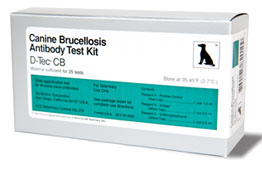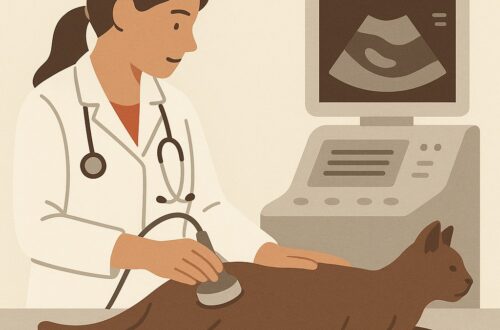As I was contemplating this week’s post, I came across a news headline about several humans becoming infected with brucellosis after drinking raw milk. I then realized I hadn’t yet shared any information about this disease in dogs. Thus, this week’s blog post was born. I hope you find the information intriguing and shareworthy. Happy reading!

Brucellosis – What is it?
Brucellosis is a serious infection in dogs caused by the bacterium, Brucella canis. There are at least ten Brucella species with specific hosts, including the cattle, goats & sheep, rodents, sheep, and pigs. Interestingly, the Brucella species that causes disease in cattle, goats, sheep, and pigs can also cause disease in dogs! Brucella canis – along with three other species – is considered a zoonotic disease – this means people may become infected too. In the United States, brucellosis is most commonly diagnosed in the Southeast.

Brucella canis is transmitted through several routes – venereal, inhalation, through the placenta, and ingestion. The bacteria may be encountered in urine, semen, milk, aborted tissues, saliva, nasal discharge, and vaginal discharge. In the body, immune cells called macrophages engulf (phagocytize) the bacteria where they then live inside the cells. The macrophages circulate to other areas of the body, particularly lymph tissue and genital organs. In these locations, the bacteria multiply and can spread further to tissues like the spleen, kidneys, eyes, intervertebral discs, and the lining around the brain and spinal cord called the meninges. Many Brucella bacteria persist within immune cells longterm, and the bacteria can be found in the bloodstream for up to 5+ years.
Brucellosis – What does it look like?
There is no breed, sex, or age predisposition for brucellosis. Male dogs appear to have more physical clinical signs because of their intact status. Common abnormal findings include inflammation and swelling of the scrotum and testicular enlargement. If the male dog is used as a stud, then the volume of his ejaculate may be reduced. Bitches often abort dead puppies between 45-60 days of gestation, and then they may have vaginal discharge for up to six weeks post-abortion.
Infected dogs may have enlarged immune organs, particularly the spleen and lymph nodes. Some develop marked discomfort in their vertebral column because of inflammation of the intervertebral discs and surrounding bone (called discospondylitis). As a result of this pain, patients are often reluctant to move, have reduced appetites, have lameness or are unsteady on their feet (called ataxia), and/or lose weight. When the eyes are affected, patients may develop uveitis, retinal detachments, corneal edema, optic neuritis, and secondary glaucoma. Patients may also develop brain inflammation called meningoencephalitis.

Brucellosis – How is it diagnosed?
A veterinarian will initially obtain a thorough patient history and perform a complete physical examination. If they have concerns about brucellosis based on this information, they will recommend some initial non-invasive blood/urine testing to both screen for the infecting organism and to evaluate the function of major organ systems. Radiographs (x-rays) of the spinal column are indicated to look for evidence of discospondylitis. Cultures of semen, vaginal discharge, and/or aborted tissues are the most definitive way to diagnose brucellosis.

Brucellosis – How is it treated?
To date, there is no uniformly accepted treatment for brucellosis in dogs. Furthermore, none of the treatments that have been used have worked 100%. Antibiotic therapy is challenging because the bacteria live inside cells where they can evade drugs. A combination of antibiotics has been shown to be more effective than single agent therapy. Intact males and females should be neutered and spayed, respectively. When an eye is infected and because an infected eye can serve as a nidus of recurrent infection, removal of the eye (called enucleation) may be recommended. Those with discomfort due to discospondylitis should be provided multimodal pain medications, and they may benefit from rehabilitation therapy. Families may find it helpful to partner with a board-certified veterinary internal medicine specialist to develop an effective treatment plan.
Infection relapse is quite common because the bacteria live inside cells. In fact, the prognosis for elimination of infection is actually very guarded even though critical illness is not common.
Under no circumstances should infected patients be used for breeding.
Kennels should be quarantined and immediately disinfected; the disinfection process should include all surfaces and equipment that could act as fomites. Families may find it helpful to collaborate with a board-certified reproductive specialist (called a theriogenologist) to develop a management plan for dogs housed in an infected kennel environment. As brucellosis is considered a zoonotic infection, people should wear personal protective equipment, particularly gloves, eye googles, and face mask. People who have been exposed to Brucella spp. should also contact their personal physicians for further advice. Brucellosis in humans is a reportable disease.
The take-away message about brucellosis in dogs…
Brucellosis is a bacterial infection that is most often sexually transmitted in vaginal discharge or semen. Diagnose is relatively straightforward, but definitive treatment is much more challenging.
To find a board-certified veterinary internal medicine specialist, please visit the American College of Veterinary Internal Medicine.
To find a board-certified veterinary theriogenologist, please visit the American College of Theriogenologists.
Wishing you wet-nosed kisses,
CriticalCareDVM






